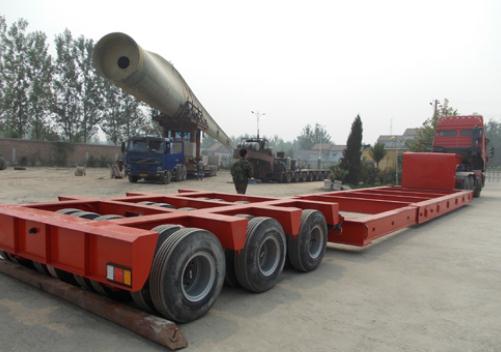Wind Turbine Blade Transport Frame
1. It is common to transport or store blades with basically vertical or basically horizontal orientation in the tangential range. A blade end frame for storing or transporting blades in vertical chord orientation is described in ep3486205a1, wherein the leading edge of the blade is supported in a plurality of sets of spanning strips suspended from opposite sides of the rigid frame.
2. Wind turbine blades usually have a much larger chord dimension than the thickness dimension, and the so-called flat flexibility in their thickness direction is greater than their flexibility in the edge direction in their chord plane. Due to various reasons, including size and stiffness considerations in different directions, there are different advantages in selecting different blade orientations during storage or transportation. The transport or storage frame of the utility model is supposed to be transported by truck, and the blade orientation that makes the chord range of the blade in the main horizontal direction is preferred. This allows the blade to use its relatively high flat directional flexibility to absorb bumps or uneven impacts from the road, for example, or to adapt to undulations in the road.
3. In addition, deploying wind turbines to a series of different places with different wind characteristics increasingly requires different blade sizes that can be used to install wind turbines in a wide range. It is advantageous to design the transport or storage frame so that it can accommodate different blades of different designs or sizes.
4. Wind turbine blades provide unique challenges in the context of storage and transportation, because their large size and weight are combined with their asymmetric shape and their sensitivity to damage if not properly handled. In addition, vibration or impact during transportation may cause the blade to detach or damage. In addition, the internal geometry of wind turbine blades can cause local areas of the blade surface to be suitable for binding forces, such as during transportation, storage or handling. Conversely, the area of the blade surface with small local internal support may not be suitable for applying force during transportation, storage or handling. If excessive pressure is applied to the relatively unsupported part of the blade surface, this may involve an increase in the probability of local damage to the blade. In addition, experience shows that the trailing edge of the blade can have different sensitivity than the leading edge of the blade. In some cases, instruments such as noise reduction or drag reduction fittings (such as serrations) may be fitted to the trailing edge of the blade. These factors all pose challenges to blade frame design, especially for frames that can be used with different blade designs.




